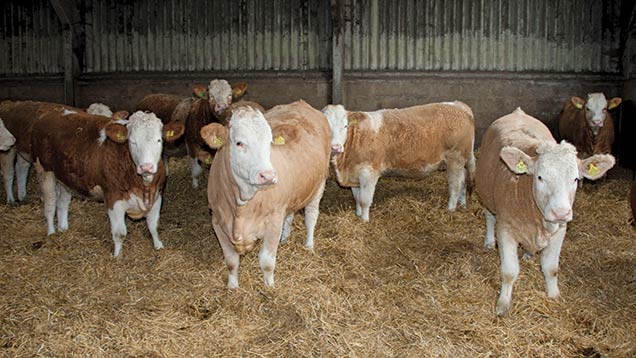How a once-bred heifer system can boost beef productivity
 © Tim Scrivener
© Tim Scrivener Finishing once-bred heifers could boost beef producers’ productivity – as well as opening up a wealth of alternative markets.
The concept of once-bred heifers has been around for a while. Instead of finishing heifers, farmers breed from them once to produce a calf, then fatten the animal for slaughter.
So far, the idea hasn’t really taken off in the UK – perhaps because once a heifer has calved she is treated as a cow rather than a prime beef animal, and therefore suffers a hefty price penalty.
However, that doesn’t mean farmers cannot tailor the system to their own circumstances and in doing so enjoy a 15-20% a year increase in productivity.
“Once-bred heifers are a very efficient way of producing beef and improving output,” says Rhidian Jones, beef and sheep consultant at Scotland’s Rural University College (SRUC).
“There aren’t that many British producers doing it yet, but I’ve got a feeling we’re going to see more of it happening as the single payment drops and people question the profitability of suckler enterprises.”
See also: Pros and cons of once-bred heifers in the beef herd
Producers should aim to calve their heifers at two years old, so they can finish them before they reach 30 months, says Mr Jones.
“You need to be very disciplined, to ensure heifers reach target weights for service and calving. If the heifer is well grown, and calves with a condition score of 2.5, then there will be no need to grow her on afterwards. It’s simply a case of fattening her.”
After calving, farmers can either allow the heifer to rear the calf for a couple of months, or wean the calf onto powdered milk within a few days.
Surrogate cows
“Another option is to twin calves onto an older cow with plenty of milk – that way you’re boosting the efficiency of surrogate cows as well as producing an extra calf,” he adds.
However, heifers must then be calving at the same time as cows, which can make for difficult management.
Whichever option producers take, they should make the system as simple as possible to maximise efficiencies.
“You want a tight calving period, so will probably synchronise and AI the heifers – and use very easy calving bulls so that everything runs smoothly,” says Mr Jones.
“If you’re weaning calves within a few days, just move the heifer onto a maintenance ration for a couple of weeks to dry her off, and then switch to a finishing diet.”
As well as producing an extra calf, producers have the additional benefit of selecting the best heifers to keep as replacements in the herd.
“You can select heifers based on fertility, calving ease, milk supply, temperament, udder shape and beef characteristics, enabling you to rapidly improve the base of your herd.”
See also: Once bred heifers could help restore the beef calf balance
Another option is to use sexed semen, to choose all bull calves for maximum beef output, or all heifer calves to produce more once-bred heifers.
Producers can forgo the suckler cow side of the enterprise altogether, instead opting to buy in dairy crossbred calves to breed once and then finish, says Mr Jones. “There is a huge amount of flexibility; once-bred heifers can suit almost any kind of system.”
The main drawback is that when finished, calved heifers are treated as cow beef rather than prime beef, resulting in a discount of about £1/kg deadweight.
The killing-out percentage is also about four percentage points lower, due to the uterus expansion and udder development.
“But the benefits of having the extra calf more than outweigh the discounted finished price,” adds Mr Jones.
“There’s no reason why once-bred heifers shouldn’t be treated as prime beef – but there are also other alternatives.”
These include selling the heifers as suckler replacements, either with or without a calf at foot. “Beef crossbreds with a calf at foot are worth quite a lot of money, so it may prove a more profitable option for some.”
It is also easy to adjust the system to free up cash flow or benefit from opportunities in different markets. “There are no hard and fast rules,” says Mr Jones.
“You can sell your heifer at any stage – as a store, a bulling heifer, in-calf, freshly-calved, or deadweight. At no point are you losing any value, and the benefits really do stack up.”
Targets
- Breed heifers at 15 months to calve at 24 months
- Ensure heifers are 65% of mature bodyweight at service
- During pregnancy, heifers should be gaining 0.7-0.8kg a day
| Target age | Target weight | |
| Weaning | 6-8 months | 250kg |
| Service | 15 months | 380-400kg |
| Calving | 24 months | 500-540kg |
| Finished | 26 months | 520-560kg |
| 30 months | 560-600kg |
Benefits of OBH for a 100-cow suckler herd
- 100 cows
- 90 live calves produced
- 45 female calves
- 40 females suitable for breeding
- Replacement rate = 20%
- 20 heifers for replacements
- 20 heifers for OBH
- Extra 18 calves produced
Source: Eblex
